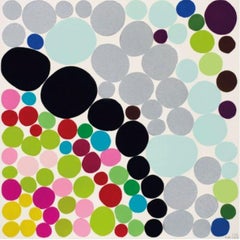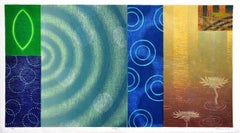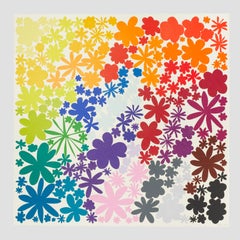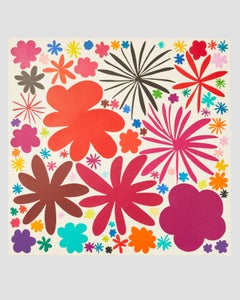Polly Apfelbaum Art
to
3
1
3
1
1
1
Overall Height
to
Overall Width
to
2
1
3
3
6,847
3,161
2,517
1,217
2
1
1
1
1
Artist: Polly Apfelbaum
Color Circle and Star
By Polly Apfelbaum
Located in New York, NY
Polly Apfelbaum
Color Circle and Star, 2004
Fabric Marker and Fabric Dye on Velvet Cotton
Signed and dated in ink by the artist on the front with artist's inkstamp.
Frame Included
Si...
Category
Early 2000s Abstract Geometric Polly Apfelbaum Art
Materials
Fabric, Dye, Ink, Mixed Media, Permanent Marker
Color Field Notes (Red)
By Polly Apfelbaum
Located in Santa Fe, NM
Edition of 43
Category
21st Century and Contemporary Contemporary Polly Apfelbaum Art
Materials
Woodcut
Durham Dogwood
By Polly Apfelbaum
Located in New York, NY
Color woodcut on Sauders Waterford paper. Initialed and numbered 102/150 in pencil. Published by Durham Press, Durham, Pennsylvania, with the blindstamp and inkstamp, verso.
Category
2010s Contemporary Polly Apfelbaum Art
Materials
Color, Woodcut
Related Items
Günther Förg, Untitled (Portfolio Pi) - Signed Woodcut Print, Abstract Art
By Günther Förg
Located in Hamburg, DE
Günther Förg (German, 1952-2013)
Untitled (from Portfolio Pi), 1995
Medium: Woodcut on wove paper
Dimensions: 80 x 60 cm
Edition of 98: Hand-signed and numbered
Category
21st Century and Contemporary Abstract Polly Apfelbaum Art
Materials
Woodcut
Lotus
By Hiroki Morinoue
Located in Lyons, CO
Color woodcut, Edition 30.
Lotus is a twenty-six color woodcut from seven woodblocks printed in an edition of 30, plus proofs, on white Thai Mulberry paper. In this print, a compe...
Category
21st Century and Contemporary Contemporary Polly Apfelbaum Art
Materials
Woodcut
Constellation - XXI Century, Contemporary Linocut & Woodcut Print, Abstract
By Maria Stelmaszczyk
Located in Warsaw, PL
MARIA STELMASZCZYK (born in 1983) Studies at the Faculty of Graphic Arts and Painting
Laboratory of Woodcut Techniques and Artistic Book at the Academy of Fine Arts Władysław Strzemi...
Category
Early 2000s Contemporary Polly Apfelbaum Art
Materials
Paper, Linocut, Woodcut
Sin título
By Sergio Hernández
Located in Cuernavaca, Morelos
Medium: Limited Edition Print.
Technique: Woodcut.
Paper: Hahnemühle 350 g.
Category
2010s Contemporary Polly Apfelbaum Art
Materials
Woodcut
Earth Cycle
By Hiroki Morinoue
Located in Lyons, CO
Color woodcut, Edition 30.
In all of Morinoue's work there is a compelling sense of place--the ocean shoreline, lava flows and Japanese gardens. He is a patient observer of nature...
Category
21st Century and Contemporary Contemporary Polly Apfelbaum Art
Materials
Woodcut
Japanese Modernist Sculptor Woodblock (Woodcut) Monotype (Monoprint) Print
By Yasuhide Kobashi
Located in Surfside, FL
Yasuhide Kobashi (古橋 矢須秀 Kobashi Yasuhide, 1931–2003) was a Japanese woodblock print artist, painter, sculptor and stage designer. He was born in Kojima in Okayama Prefecture. His father was a ceramic clay artist and head of the Kyoto Industrial Craft Company. Kobashi learned printmaking from the sōsaku hanga (creative prints) master Unichi Hiratsuka (1895–1997). In 1955, Kobashi graduated from the Kyoto College of Crafts and Textiles, and in 1959, he moved to New York City. At first he was sponsored by Lincoln Kirstein of the New York City Ballet, who had visited his studio in Kyoto and commissioned a number of works from him. Elaine De Kooning, art critic and wife of influential Abstract Expressionist Willem De Kooning recommended Kobashi to the Allan Stone Gallery, He would continue to work with this gallery for more than 30 years.
When Kobashi moved to New York in 1959, many American intellectuals and artists were eager to learn about Japan. Among the early influences to reach a wide cross section of American society was Suzuki Daisetsu's (1870-1966) Introduction to Zen Buddhism, published in English in 1949 with a preface by the noted psychologist Carl Jung.
Nelson Rockefeller (governor of New York and later vice-president) was Kobashi's patron, and acquired one of the artist's sculptures for the New York State Executive Mansion in Albany. As a young man he was exposed to a wide range of arts, including sculpture, stage design, carpentry, stone cutting, ceramics, calligraphy, painting, and furniture design. Most notably, he studied woodblock printmaking under Hiratsuka Unichi (1895-1997), one of the leading innovators in the Creative Print (ssaku-hanga) movement that advocated total artistic control by a single artist over the entire printmaking process, in contrast to the traditional methods of ukiyo-e in which designer, carver, printer, and publisher all had a role in production.
Kobashi is best known for his sosaku hanga woodblock prints and his sculptures intended to be rearranged, which he called "self-constructions". The Cleveland Museum of Art, the Honolulu Museum of Art, the Metropolitan Museum of Art, the Museum of Modern Art (MoMA New York City), the Neuberger Museum of Art (Purchase, New York), the Albright Knox, the Weisman Art Museum (University of Minnesota, Minneapolis), and Southern Illinois University Edwardsville are among the public collections holding work by Kobashi.
Yasuhide Kobashi created some of his first prints in New York at the Pratt Graphic Art Center. He became a member of the Society of Independent Artists and exhibited regularly with them.
He is included in the book JAPANESE SCULPTORS: Isamu Noguchi, Yayoi Kusama, Akio Takamori, Yoshimoto Nara...
Category
20th Century Modern Polly Apfelbaum Art
Materials
Monoprint, Monotype, Woodcut
Raoul Ubac - Rythm - Original Woodcut
By Raoul Ubac
Located in Collonge Bellerive, Geneve, CH
Raoul Ubac - Rythm - Original Woodcut
Title: Rythm
Dimensions: 32 x 24 cm
Revue Art de France
The painter-sculptor Raoul Ubac was born in 1910 in Malmédy (Ardennes, Belgium). He wen...
Category
1960s Abstract Expressionist Polly Apfelbaum Art
Materials
Woodcut
"High and Low II", Abstract Patterns, Geometric Abstraction, Woodcut Monoprint
Located in Philadelphia, PA
This piece titled "High and Low II" is an original piece by Alexis Nutini and is made from a woodcut monoprint mounted on panel. This piece measures 9.5"h x 14.5"w.
Born in Mexico ...
Category
21st Century and Contemporary Contemporary Polly Apfelbaum Art
Materials
Wood Panel, Monoprint, Woodcut
Leaf Ocean - Leaves in Blue Ocean Large Cyanotype Woodcut Monotype
By Katherine Warinner
Located in Morgan Hill, CA
"Leaf Ocean" is a dramatic cyanotype and woodcut monoprint with contrasting layers and objects abstracted from nature. Black, silver, and white leaves float on top of a watery background. In her creative process, Katherine scans organic material which she then refines into digital files. The images are then then cut out of wood using a laser cutter. Katherine prints the inked wood shapes in combination with ink washes, in different arrangements making each print unique. For more works by Katherine Warriner and new listings, follow our storefront at Colibri Gallery...
Category
2010s Contemporary Polly Apfelbaum Art
Materials
Monotype, Woodcut, Photogram
Shapes, Mid Century Modern Abstract Colored Woodcut, Geometric Fine Art Print
By Edward Marecak
Located in Denver, CO
Block print on linen by Edward Marecak (1919-1993) titled Shapes. Presented in a custom frame with all archival materials, outer dimensions measure 29 x 19 ¼ x 1 ⅛ inches. Image size...
Category
20th Century Abstract Polly Apfelbaum Art
Materials
Woodcut
H 29 in W 19.25 in D 1.25 in
1950s Abstract Composition in Brown, Orange and Blue with Black Parallel Lines
By Herbert Bayer
Located in Denver, CO
Watercolor and ink on paper of an abstract composition of brown, orange and blue shapes between black parallel lines throughout the the piece by Herbert Bayer (1900-1985). Presented in a custom black frame with all archival materials. Framed dimensions measure 17 ⅞ x 22 ⅝ x 1 inches. Image size is 10 ¼ x 15 ½ inches.
Painting is clean and in very good condition - please contact us for a detailed condition report.
Expedited and international shipping is available - please contact us for a quote.
About the Artist:
Herbert Bayer enjoyed a versatile sixty-year career spanning Europe and America that included abstract and surrealist painting, sculpture, environmental art, industrial design, architecture, murals, graphic design, lithography, photography and tapestry. He was one of the few “total artists” of the twentieth century, producing works that “expressed the needs of an industrial age as well as mirroring the advanced tendencies of the avant-garde.”
One of four children of a tax revenue officer growing up in a village in the Austrian Salzkammergut Lake region, Bayer developed a love of nature and a life-long attachment to the mountains. A devotee of the Vienna Secession and the Vienna Workshops (Wiener Werkstätte) whose style influenced Bauhaus craftsmen in the 1920s, his dream of studying at the Academy of Art in Vienna was dashed at age seventeen by his father’s premature death.
In 1919 Bayer began an apprenticeship with architect and designer, Georg Schmidthamer, where he produced his first typographic works. Later that same year he moved to Darmstadt, Germany, to work at the Mathildenhöhe Artists’ Colony with architect Emanuel Josef Margold of the Viennese School. As his working apprentice, Bayer first learned about the design of packages – something entirely new at the time – as well as the design of interiors and graphics of a decorative expressionist style, all of which later figured in his professional career.
While at Darmstadt, he came across Wassily Kandinsky’s book, Concerning the Spiritual in Art, and learned of the new art school, the Weimar Bauhaus, in which he enrolled in 1921. He initially attended Johannes Itten’s preliminary course, followed by Wassily Kandinsky’s workshop on mural painting. Bayer later recalled, “The early years at the Bauhaus in Weimar became the formative experience of my subsequent work.” Following graduation in 1925, he was appointed head of the newly-created workshop for print and advertising at the Dessau Bauhaus that also produced the school’s own print works. During this time he designed the “Universal” typeface emphasizing legibility by removing the ornaments from letterforms (serifs).
Three years later he left the Bauhaus to focus more on his own artwork, moving to Berlin where he worked as a graphic designer in advertising and as an artistic director of the Dorland Studio advertising agency. (Forty years later he designed a vast traveling exhibition, catalog and poster -- 50 Jahre Bauhaus -- shown in Germany, South America, Japan, Canada and the United States.) In pre-World War II Berlin he also pursued the design of exhibitions, painting, photography and photomontage, and was art director of Vogue magazine in Paris. On account of his previous association with the Bauhaus, the German Nazis removed his paintings from German museums and included him among the artists in a large exhibition entitled Degenerate Art (Entartete Kunst) that toured German and Austrian museums in 1937.
His inclusion in that exhibition and the worsening political conditions in Nazi Germany prompted him to travel to New York that year with Marcel Breuer, meeting with former Bauhaus colleagues, Walter Gropius and László Moholy-Nagy to explore the possibilities of employment after immigration to the United States. In 1938 Bayer permanently relocated to the United States, settling in New York where he had a long and distinguished career in practically every aspect of the graphic arts, working for drug companies, magazines, department stores, and industrial corporations. In 1938 he arranged the exhibition, “Bauhaus 1919-1928” at the Museum of Modern Art, followed later by “Road to Victory” (1942, directed by Edward Steichen), “Airways to Peace” (1943) and “Art in Progress” (1944).
Bayer’s designs for “Modern Art in Advertising” (1945), an exhibition of the Container Corporation of America (CAA) at the Art Institute of Chicago, earned him the support and friendship of Walter Paepcke, the corporation’s president and chairman of the board. Paepcke, whose embrace of modern currents and design changed the look of American advertising and industry, hired him to move to Aspen, Colorado, in 1946 as a design consultant transforming the moribund mountain town into a ski resort and a cultural center. Over the next twenty-eight years he became an influential catalyst in the community as a painter, graphic designer, architect and landscape designer, also serving as a design consultant for the Aspen Cultural Center.
In the summer of 1949 Bayer promoted through poster design and other design work Paepcke’s Goethe Bicentennial Convocation attended by 2,000 visitors to Aspen and highlighted by the participation of Albert Schweitzer, Arthur Rubenstein, Jose Ortega y Gasset and Thornton Wilder. The celebration, held in a tent designed by Finnish architect Eero Saarinen, led to the establishment that same year of the world-famous Aspen Music Festival and School regarded as one of the top classical music venues in the United States, and the Aspen Institute for Humanistic Studies in (now the Aspen Institute), promoting in Paepcke’s words “the cross fertilization of men’s minds.”
In 1946 Bayer completed his first architecture design project in Aspen, the Sundeck Ski Restaurant, at an elevation of 11,300 feet on Ajax Mountain. Three years later he built his first studio on Red Mountain, followed by a home which he sold in 1953 to Robert O. Anderson, founder of the Atlantic Richfield Company who became very active in the Aspen Institute. Bayer later designed Anderson’s terrace home in Aspen (1962) and a private chapel for the Anderson family in Valley Hondo, New Mexico (1963).
Transplanting German Bauhaus design to the Colorado Rockies, Bayer created along with associate architect, Fredric Benedict, a series of buildings for the modern Aspen Institute complex: Koch Seminar Building (1952), Aspen Meadows guest chalets and Center Building (both 1954), Health Center and Aspen Meadows Restaurant (Copper Kettle, both 1955). For the grounds of the Aspen Institute in 1955 Bayer executed the Marble Garden and conceived the Grass Mound, the first recorded “earthwork” environment In 1973-74 he completed Anderson Park for the Institute, a continuation of his fascination with environmental earth art.
In 1961 he designed the Walter Paepcke Auditorium and Memorial Building, completing three years later his most ambitious and original design project – the Musical Festival Tent for the Music Associates of Aspen. (In 2000 the tent was replaced with a design by Harry Teague.) One of Bayer’s ambitious plans from the 1950s, unrealized due to Paepcke’s death in 1960, was an architectural village on the outskirts of the Aspen Institute, featuring seventeen of the world’s most notable architects – Walter Gropius, Marcel Breuer, I.M. Pei, Minoru Yamasaki, Edward Durrell Stone and Phillip Johnson – who accepted his offer to design and build houses.
Concurrent with Bayer’s design and consultant work while based in Aspen for almost thirty years, he continued painting, printmaking, and mural work. Shortly after relocating to Colorado, he further developed his “Mountains and Convolutions” series begun in Vermont in 1944, exploring nature’s fury and repose. Seeing mountains as “simplified forms reduced to sculptural surface in motion,” he executed in 1948 a series of seven two-color lithographs (edition of 90) for the Colorado Springs Fine Arts Center. Colorado’s multi-planal typography similarly inspired Verdure, a large mural commissioned by Walter Gropius for the Harkness Commons Building at Harvard University (1950), and a large exterior sgraffito mural for the Koch Seminar Building at the Aspen Institute (1953).
Having exhausted by that time the subject matter of “Mountains and Convulsions,” Bayer returned to geometric abstractions which he pursued over the next three decades. In 1954 he started the “Linear Structure” series containing a richly-colored balance format with bands of sticks of continuously modulated colors. That same year he did a small group of paintings, “Forces of Time,” expressionist abstractions exploring the temporal dimension of nature’s seasonal molting. He also debuted a “Moon and Structure” series in which constructed, architectural form served as the underpinning for the elaboration of color variations and transformations.
Geometric abstraction likewise appeared his free-standing metal sculpture, Kaleidoscreen (1957), a large experimental project for ALCOA (Aluminum Corporation of America) installed as an outdoor space divider on the Aspen Meadows in the Aspen Institute complex. Composed of seven prefabricated, multi-colored and textured panels, they could be turned ninety degrees to intersect and form a continuous plane in which the panels recomposed like pieces of a jigsaw puzzle. He similarly used prefabricated elements for Articulated Wall, a very tall free-standing sculpture commissioned for the Olympic Games in Mexico...
Category
1950s Abstract Geometric Polly Apfelbaum Art
Materials
Paper, Ink, Mixed Media, Watercolor
H 17.75 in W 22.5 in D 1 in
Untitled (Līnea Study), 2022
Located in Washington, DC
Original work by Mary Early. Graphite, wax crayon, and sumi ink on Arches paper, 12.25 x 16".
"The production, or “pouring,” of beeswax elements has become a meditative process that is integral to my art practice, serving as an observation of time, materials, and space. The raw beeswax I use has taken its form at the end of a long series of natural processes followed by a manufacturing process, and once it is in my hands, the studio becomes a factory. I apply my own methods of transforming the material by casting the beeswax into three-dimensional forms. Once I have fixed both a place and a time in the future for a potential installation, I begin to determine how the beeswax lines will take their aggregated shape in that space and, simultaneously, how many lines might be manufactured for that particular space in the amount of time available."
Mary Early (born 1975, Washington, DC) lives and works in Washington, DC. She studied visual art, film, and video at Bennington College, and her work has been exhibited at the United States Botanic Garden, Washington Project for the Arts, the Corcoran Gallery of Art, Second Street Gallery (Charlottesville, VA), Hemphill Fine Arts (Washington DC,) the Austrian Cultural Forum (Washington DC), Galerie Im Ersten (Vienna, Austria), Kloster Schloss Salem (Salem, Germany), Kunstlerbund Tubingen (Tubingen, Germany), and the American University Museum (Washington DC) among other regional and national galleries.
Her early work incorporated formed concrete, tarpaper and paraffin wax, fabricated wood structures, and, increasingly over the years, surfaces coated with wax as a method of preserving or concealing an object within. Recent works have relied solely on solid forms cast in wax, abandoning the use of any permanent armature. Temporary installations are guided by schematic drawings and plans, which then serve as a permanent record.
In 2014 she exhibited her first large-scale installation of wax lines at Second Street Gallery in Charlottesville, VA, followed by temporary installations in response to various historical sites in Salem, Germany (2016) and Tubingen Germany (2017). In 2017 she participated in the exhibition “Twist-Layer-Pour” at the American University Museum, which included Untitled [Curve], an installation of thousands of beeswax lines assembled on the floor of the museum. In spring 2018 she was commissioned to create a temporary installation at the Sun Valley Center for the Arts, Sun Valley Idaho. This work took the form of two intersecting curtains of hanging beeswax lines bisecting a 12’ foot x 18’ foot room, providing an immersive and enclosed viewing space.
Early’s work is included in the collections of the US Department of State/Embassy of Panama, Kimpton Hotels, and the District of Columbia Art Bank among other public and private collections. She is a recipient of the Artist Fellowship Grant from the DC Commission on Arts & Humanities, Washington DC (2020, 2019, 2018, 2017, 2016, 2015, 2014, 2011, 2009, 2007).
Early is the director of HEMPHILL Fine Arts, Washington, DC, and serves on the boards of Hamiltonian Artists and Washington Sculptors Group. She handles the work of contemporary artists and artist estates, including the work of William Christenberry, Colby Caldwell, Hedieh Javanshir Ilchi, Linling Lu, Mingering Mike, Robin Rose, Renée Stout...
Category
21st Century and Contemporary Abstract Geometric Polly Apfelbaum Art
Materials
Archival Paper, Graphite, Wax Crayon, Sumi Ink
Previously Available Items
Love Potpourri
By Polly Apfelbaum
Located in Santa Fe, NM
Edition of 25
Category
21st Century and Contemporary Contemporary Polly Apfelbaum Art
Materials
Woodcut
Persephone (Red)
By Polly Apfelbaum
Located in Santa Fe, NM
Edition 20/35
Category
21st Century and Contemporary Polly Apfelbaum Art
Materials
Woodcut
Hudson River Valley Nirvana OR
By Polly Apfelbaum
Located in New York, NY
2016, woodblock print on handmade Japanese paper, 36 7/8 x 36 1/2 inches, edition of 15, signed and dated by the artist along bottom
In her fabric sculptures, installations, ceram...
Category
Pop Art Polly Apfelbaum Art
Materials
Woodcut
Lover's Leap 37
By Polly Apfelbaum
Located in New York, NY
unique woodblock monoprint on handmade paper, 47 x 47 inches
Category
21st Century and Contemporary Other Art Style Polly Apfelbaum Art
Dogwood Leap 7
By Polly Apfelbaum
Located in Houston, TX
Category
Polly Apfelbaum Art
Polly Apfelbaum art for sale on 1stDibs.
Find a wide variety of authentic Polly Apfelbaum art available for sale on 1stDibs. If you’re browsing the collection of art to introduce a pop of color in a neutral corner of your living room or bedroom, you can find work that includes elements of orange and other colors. You can also browse by medium to find art by Polly Apfelbaum in woodcut print, dye, fabric and more. Much of the original work by this artist or collective was created during the 21st century and contemporary and is mostly associated with the abstract style. Not every interior allows for large Polly Apfelbaum art, so small editions measuring 12 inches across are available. Customers who are interested in this artist might also find the work of Caio Fonseca, Emerson Woelffer, and Elizabeth Murray. Polly Apfelbaum art prices can differ depending upon medium, time period and other attributes. On 1stDibs, the price for these items starts at $5,000 and tops out at $8,200, while the average work can sell for $5,750.






